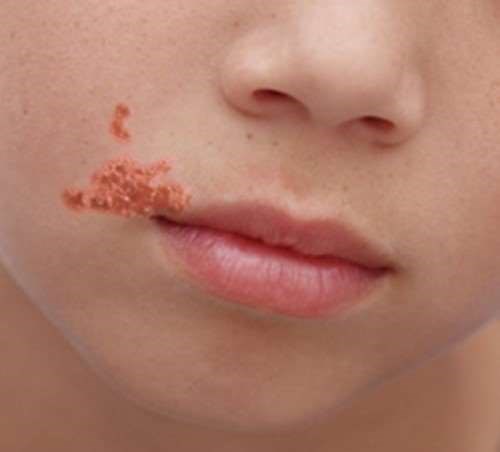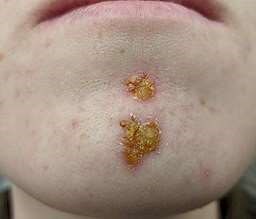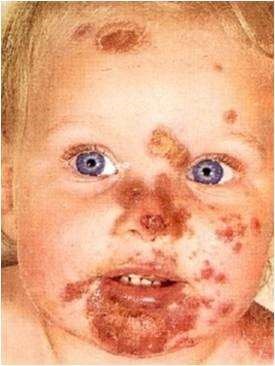Impetigo
Impetigo is a common infection of the skin. It is contagious, which means it can be passed on by touching. It is quite common in young children but it can affect anybody of any age. Antibiotic cream usually clears this type of skin problem quickly. Antibiotic tablets or liquid medicines are sometimes needed.
What is impetigo?
Impetigo is a skin infection. It is usually caused by a germ (bacterium). Often, one of the following three types of bacterial infection is responsible for impetigo:
- Staphylococcus aureus (the most common cause).
- Streptococcus pyogenes (also known as group A streptococcus).
- Meticillin-resistant Staphylococcus aureus (MRSA). This is a newer type of bacterium which has become resistant to many antibiotics.
Impetigo may be classed as primary or secondary:
- In primary impetigo, the infection affects healthy skin.
- In secondary impetigo, the infection affects skin that is already 'broken' by other skin conditions. For example, skin with eczema, psoriasis or a cut sometimes develops a secondary impetigo.
Impetigo can also be classed as bullous type, non-bullous type or ecthyma.
What does impetigo look like?
Non-bullous impetigo
This is the most common form of impetigo. The rash typically appears 4-10 days after you have been infected with bacteria. Small fluid-filled blisters develop at first. You may not see the blisters, as they usually burst to leave red sores and scabby patches on the skin.
Sometimes only one or two patches develop. They often look like moist, golden crusts (like cornflakes) stuck on to the skin. An area of redness (inflammation) may develop under each patch. Sometimes the affected area is just red and inflamed - especially if the 'crust' is picked or scratched off.
The nose and mouth is the one of the most common parts of the body affected but impetigo can occur on any area of the skin. Patches of impetigo vary in size but are usually quite small - a centimetre or so to begin with. Impetigo can spread. Smaller 'satellite' patches may develop around an existing patch and spread the infection outwards.
Impetigo close to mouth

By CNX OpenStax, CC BY 4.0, via Wikimedia Commons
Impetigo

By James Heilman, MD, CC BY-SA 4.0, via Wikimedia Commons
Impetigo affecting the face

By Pp96, CC BY-SA 4.0, via Wikimedia Commons
Bullous impetigo
This type of impetigo tends to look like larger blisters. The skin on the top of these blisters is very thin and peels off, leaving large red raw areas underneath. It may occur on your face, arms, legs, or bottom. It is more likely in areas which already have another skin condition, such as eczema.
Ecthyma
This is a more uncommon type of impetigo where the breaks in the skin are quite deep, forming ulcers.
How common is impetigo?
Impetigo commonly occurs in children but it can affect anyone at any age. It occurs more commonly in warm humid weather.
Is impetigo contagious?
Impetigo is contagious, which means it can be passed on by touching. Sometimes outbreaks occur in families or in people who live in close communities, such as army barracks.
You are more prone to develop impetigo if you have diabetes or if you have a weakened immune system (for example, if you are having chemotherapy).
Impetigo treatment
There is a good chance that impetigo will clear without treatment after 2-3 weeks. However, treatment is usually advised as impetigo is contagious and severe infection sometimes develops.
Hydrogen peroxide 1% cream can be used for localised non-bullous impetigo if you are not feeling unwell.
Impetigo can also be treated with antibiotics. A medication called fusidic acid can be used in the form of an antibiotic cream for five days. This is the usual topical antibiotic treatment for a few small patches of impetigo on the skin.
Another medication called mupirocin cream also used to be used for mild uncomplicated impetigo. If it is not too sore, the crusts should be cleaned off the skin with warm soapy water before the cream is applied. This allows the antibiotic to penetrate into the skin.
Antibiotic treatment in the form of liquid medicine or tablets may be prescribed to treat impetigo in some situations. This may be needed if, for example:
- The rash is more widespread.
- The infection is spreading, despite using the cream.
- The infection has come back despite treatment.
- You have a poor immune system (immunosuppression).
- You are generally unwell with symptoms such as high temperature (fever) and swollen lymph glands.
In such cases, the treatment of choice is oral antibiotics. The first of which is oral flucloxacillin, taken for seven days. However, if you are allergic to penicillin, the recommended alternative is oral clarithromycin for the same length of time. Other antibiotic medicines may be used if the infection is MRSA.
Avoiding passing impetigo on to others
As impetigo is contagious (ie the infected person can pass it on by touching):
- Try not to touch patches of impetigo and do not allow other children to touch them.
- Wash your hands after touching a patch of impetigo and after applying antibiotic cream.
- Don't share towels, flannels, bathwater, etc, until the infection has gone.
- Children should be kept off school or nursery until there is no more blistering or crusting, or until 48 hours after antibiotic treatment has been started.
- Adults with impetigo should also stay off work until crusts have dried and scabbed over, or until 48 hours after antibiotics have been started.
Some uncommon aspects of impetigo
If treatment does not work
Tell your doctor if the initial treatment for impetigo does not work. A possible cause for this is if the germ (bacterium) causing the infection is resistant to the prescribed cream or tablet. A switch to a different antibiotic is sometimes needed if the first does not work.
Sometimes your doctor will take a swab to see which germ is causing the infection. A swab is a small ball of cotton wool on the end of a stick which is used to obtain mucus and cells. This sample is examined under a microscope in a laboratory. The result will help guide the best choice of treatment.
If your impetigo returns (recurs)
It is common for children to have one or two bouts of impetigo at some stage. However, some people have recurring bouts of impetigo. A possible cause for this is that the bacteria that cause the infection can sometimes live in ('colonise') the nose. They do no harm there but sometimes spread out and multiply on the face to cause impetigo.
If this is suspected, your doctor may take a swab of the nose. The swab is then sent to the laboratory to look for certain colonising bacteria. If necessary, a course of antibiotic cream applied to the area just inside the nose can clear these bacteria. The cream most often used in these cases is called Naseptin®.
Some things to look out for
Another skin infection called cellulitis is sometimes mistaken for impetigo. Cellulitis is a 'deeper' skin infection. Normally, with cellulitis the area of skin affected is larger, the skin is red, swollen and tender and there are not usually any blisters or crusts like impetigo. Cellulitis usually needs prompt treatment.
See the separate leaflet called Cellulitis and Erysipelas for more details. In particular, see a doctor urgently if cellulitis develops close to an eye.
A patch of impetigo on the face near to the mouth is sometimes confused with a cold sore. Cold sores are due to a viral infection and tend to recur in the same place from time to time. See the separate leaflet called Cold Sores for more details.
Further reading and references
Impetigo: antimicrobial prescribing; NICE Guidance (February 2020)
Impetigo; Primary Care Dermatology Society (PCDS)
Impetigo; NICE CKS, August 2022 (UK access ony)
Impetigo; British Association of Dermatologists, February 2021